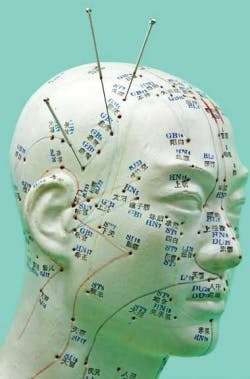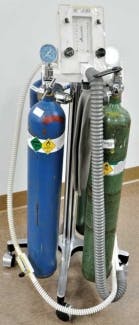Pain control
Keep exploring resources that will reduce anxiety and pain
by Vaishali Singhal, DMD, MS
In the dental office setting, practitioners have a variety of options available for pain management during dental procedures. One important option that is often overlooked is staff demeanor. A confident and friendly office staff with a reassuring demeanor can put even reluctant patients at ease. Good interpersonal skills will allow patients to feel more comfortable in the dental office setting. This positive psychological impact will allow the chosen pain management technique to be more effective. For minor procedures, a patient who is not apprehensive and is comfortable in the dental environment may not require additional pain management options.
Some patients benefit from various nonpharmacological pain management methods. Self-hypnosis, for example, is used to achieve relaxation. The patient may achieve this through a specific thought that he or she focuses on, such as “I am relaxed and comfortable.” Patients spend a few quiet minutes relaxing the muscles in their bodies and slowing the rate of breathing while repeating their chosen thought. This technique may not work for all patients but may be successful with some. Patients who find this method beneficial may need to practice it everyday to achieve the maximum benefit when the need arises.
Besides pain management, hypnosis may also be used in dentistry to control a severe gag reflex during or to change habits such as bruxism. For the more apprehensive patient, hypnosis may be combined with sedation to achieve a more comfortable environment. Some dentists are trained in hypnosis and find that the use of this relaxation technique not only creates a more relaxing environment for the patient receiving the treatment, but also increases productivity for the practitioner.
Acupuncture and acupressure are two other nonpharmacological methods sometimes used in pain management. Acupuncture is a form of traditional and holistic medicine, which has been used beneficially in China for thousands of years. It is now accepted worldwide and is used in many areas of health care. Although very few studies have been conducted about the benefits of acupuncture for pain management in dentistry, the available data does demonstrate that acupuncture can alleviate anxiety and post-operative pain in some cases, thus eliminating the use of sedatives.
Although very few studies have been conducted about the benefits of acupuncture for pain management in dentistry, the available data does demonstrate that acupuncture can alleviate anxiety and post-operative pain in some cases, thus eliminating the use of sedatives.
Acupuncture uses fine needles that are inserted in strategic locations on the body to promote the healing process. It is believed that acupuncture affects the chemical in the body that influences pain — catecholamines such as dopamine, (opioid-like compounds produced by the brain that relieve pain) and gamma aminobutyric acid (GABA) — and that the release of these compounds results in an anti-inflammatory, sedative, and pain-relieving effect.
Acupressure uses pressure points to allow the body to use its natural healing processes. The locations on the body are the same as those used in acupuncture; however, acupressure uses gentle pressure in those areas whereas acupuncture uses needles. Acupressure does not only enable healing but also allows for a state of deep relaxation.
Patients familiar with acupressure points on the body may utilize this technique to allow for a state of relaxation during dental procedures. Offices that utilize holistic practices and massage therapy during treatment may also offer acupressure as a method of relaxation during procedures. Acupressure, like acupuncture, releases the body’s natural endorphins to allow for pain management and relaxation. Both ancient Asian methods have also been used by patients to manage toothaches until they were able to get to the dental office for definitive treatment.
Relaxation therapy may also be helpful to some patients. We all face stress on a daily basis. For some patients, a visit to the dental office itself may be a stressful experience. When the body is stressed, catecholamines such as epinephrine are released, putting the patient into a fight-or-flight situation, leading to further stress. This physical state lowers the tolerance for pain and heightens anxiety.
Patients who are able to use relaxation therapy either on their own or with the help of a dental practitioner can benefit greatly from this practice. Using music is a simple and effective method to create a relaxing atmosphere. Some patients may bring their own music, or the office may keep a variety of music available for patients to listen to on provided headsets. The type of music that an office has available for a patient depends on the patients being treated. For example, does the office treat mostly senior citizens or is it a pediatric-based practice? Listening to a recording, which provide instructions on relaxation or guided imagery, will also help the patient to feel more comfortable and be more tolerant of any minor discomforts in the dental office during procedures. Deep breathing exercises are also a simple and effective method that will allow the patient to relax.
Procedures requiring pharmacological options
The above methods are useful for all patients during a minor procedure. However, some dental office procedures may require pharmacological methods of pain control in addition to the preceding holistic methods. A variety of pharmacological options for pain control include local anesthesia, oral sedation, intramuscular (IM) sedation, and nitrous oxide sedation, allowing conscious sedation and pain management.
Administration of local anesthesia allows for a safe and efficient way of pain management — the most commonly used method in dentistry today. Local anesthetics may be used to anesthetize either an isolated tooth through an infiltration injection or a quadrant with the administration of a block injection. Local anesthetics function by temporarily blocking the action potential in the nerve at the site of administration. They may be short-acting, intermediate-acting, or long-acting.
The selection of local anesthesia is dependent on the length of the procedure and/or the need for post-operative pain control. Some may contain vasoconstrictors such as epinephrine to allow for a greater depth and duration of anesthesia. The patient’s medical history must be thoroughly considered prior to selecting a local anesthetic for use. Although a traditional syringe, needle, and carpule can administer a local anesthetic to a patient, some practitioners prefer to use a computer-controlled local anesthetic delivery system (CCLAD). It is believed that this type of system leads to greater patient comfort as they allow for greater operator tactile sense, as well as the computer-controlled flow rate of anesthesia.
Oral sedatives may be an option for highly anxious or fearful patients, young children, and mentally challenged patients. Valium and chloral hydrate are two common medications. This option allows the patient to remain conscious yet comfortably sedated during the procedure. Patients may be asked to take the sedative medication at home prior to the appointment. In this manner, they are sedated when they are at the office for the procedure. Some offices may administer the medication and have the patient wait while it takes effect. Older antihistamines such as hydroxyzine cause mild sedation and also decrease salivary secretions, creating a dry working field for the dental practitioner. Regardless of when the patient takes the medication, a family member will need to drive the patient to and from the appointment.
Intramuscular (IM) sedation is an option for anxious or fearful patients who may need to be sedated for a dental procedure. The sedative injection is administered either in the thigh or the upper arm and starts to take effect within 30 minutes. Special training is required for dentists who opt to use this pain management technique. A knowledge of medications and how much can be safely administered to a patient is critical.
One drawback to IM sedation is that the results may be unpredictable. The drug cannot be titrated and the rate of absorption from the injection sites varies greatly from patient to patient. As a result, some patients may be oversedated and some may be undersedated. Because of the lack of predictability, this is the least frequently used method in adults. However, when utilized, equipment such as a pulse oximeter (which will allow the practitioner to monitor the vital signs of the patient) is required. Reversal agents must also be available in the office in case of oversedation.
Nitrous oxide and oxygen (N2O/O2) sedation is a commonly used method of inhalation conscious sedation in the dental office. Nitrous oxide, a weak general anesthetic, is delivered with a minimum of 30% oxygen to the patient via a nasal hood. This combination reduces anxiety, raises the pain threshold, and produces a state of Stage I anesthesia. The patient is relaxed and mildly sedated yet able to respond and maintain a patent airway.
Because nitrous oxide has a very low solubility in the blood, it has a rapid onset and also allows for a rapid recovery. Because of this property, patients do not need to be brought to the office by a family member nor do they need to be released to a family member at the end of the appointment. At the end of the appointment, 100% of oxygen is delivered to the patient for five minutes. This allows full recovery of the patient. He/she is able to drive, go to work, and conduct their day as they normally would. Nitrous oxide can also be safely combined with other pharmacological methods of pain control such as local anesthesia, oral, IM and intravenous sedatives.
Nitrous oxide has a very low solubility in the blood, it has a rapid onset and also allows for a rapid recovery.
General anesthesia (GA) is utilized in dentistry for the most fearful and phobic patients. GA is performed in a hospital setting where full monitoring and recovery equipment is available. General anesthetic medications many times are combined with nitrous oxide during procedures. Nitrous oxide enhances the effect of other general anesthetics; combining the medications allows less of the more potent drug to be used, increasing the safety factor for the patient. During a state of GA, the patient is maintained in Stage III anesthesia. Just as for IV sedation, the patient is continuously monitored for level of consciousness, respiration, oxygen concentration of the blood, heart rate and rhythm, as well as blood pressure.
GA does involve risks and pre-operative tests for physical status must be conducted due to the risks involved. As recovery may take several hours, patients must be released to a family member once adequately recovered. Advanced training and an anesthesia team are required. As a result, GA is not the recommended option for routine dental procedures but may be beneficial in invasive surgical procedures. If the goal is to help the patient overcome anxiety, GA is not the best option. Instead, the holistic methods and nitrous oxide sedation described earlier may help the patient overcome dental anxieties.
It is important to keep in mind that for all patients, an accurate and updated medical history must be maintained. For all sedation procedures, a thorough pre-operative evaluation of the patient is required. Depending on the procedure, these may include a physical exam completed by a physician, pre-operative and post-operative vitals, patient’s weight to calculate appropriate dose for IM and IV sedation, monitoring of patient vitals for the duration of the sedation, and laboratory tests. It is important to maintain accurate records of the sedation procedure. The records should include, but are not limited to, medical history, pre-operative, intra-operative and post-operative vitals, duration of anesthesia, amount of anesthesia delivered, recovery time, and any negative effects caused by the anesthesia.
Vaishali Singhal DMD, MS, is an associate professor at the University of Medicine and Dentistry of New Jersey.
References
Acupuncture and dentistry. (n.d.). Retrieved from www.acupuncture.org.uk/research-fact-sheets/dentistry.html.
Acupuncture and pain management in madison wisconsin. (n.d.). Retrieved from http://acupunctureherbalmd.com/blog/?p=51.
Clark M, and Brunick A. (2007). Handbook of nitrous oxide and oxygen sedation. Mosby.
Gache M. (2010). Acupressure.com. Retrieved from www.acupressure.com.
Haveles E. (2010). Applied pharmacology for the dental hygienist. Maryland Heights: Mosby.
Hypnosis, self-hypnosis, relaxation and nlp. (n.d.). Retrieved from www.dentalfearcentral.org/dental_hypnosis.html.
Malamed S. (2004). Handbook of local anesthesia. St. Louis: Mosby.
National Institute for Health, national Center for Complementary and Alternative Medicine. (2010). Acupuncture for pain (NCCAM Publication No. D435). Bethesda, Maryland: NCCAM. Retrieved from http://nccam.nih.gov/health/acupuncture/acupuncture-for-pain.htm.
Pain management-complementary approaches. (2004). Retrieved from www.healingchronicpain.org/content/introduction/comp_acup.asp.
Rosted P. (1998). The use of acupuncture in dentistry: a review of the scientific validity of published papers. Oral Diseases, 4(2), Retrieved from http://www.ncbi.nlm.nih.gov/pubmed/9680898.
USC school of dentistry teaches hypnosis as an alternative to needles and novocain. (2008, October 1). Retrieved from www.medicalnewstoday.com/articles/123764.php.
Past RDH Issues



